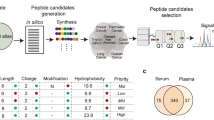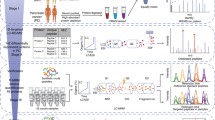Abstract
Purpose
Noninvasive and convenient biomarkers for early diagnosis of breast cancer remain an urgent need. The aim of this study was to discover and identify potential protein biomarkers specific for breast cancer.
Methods
Two hundred and eighty-two (282) serum samples with 124 breast cancer and 158 controls were randomly divided into a training set and a blind-testing set. Serum proteomic profiles were analyzed using SELDI-TOF-MS. Candidate biomarkers were purified by HPLC, identified by LC-MS/MS and validated using ProteinChip immunoassays and western blot technique.
Results
A total of 3 peaks (m/z with 6,630, 8,139 and 8,942 Da) were screened out by support vector machine to construct the classification model with high discriminatory power in the training set. The sensitivity and specificity of the model were 96.45 and 94.87%, respectively, in the blind-testing set. The candidate biomarker with m/z of 6,630 Da was found to be down-regulated in breast cancer patients, and was identified as apolipoprotein C-I. Another two candidate biomarkers (8,139, 8,942 Da) were found up-regulated in breast cancer and identified as C-terminal-truncated form of C3a and complement component C3a, respectively. In addition, the level of apolipoprotein C-I progressively decreased with the clinical stages I, II, III and IV, and the expression of C-terminal-truncated form of C3a and complement component C3a gradually increased in higher stages.
Conclusions
We have identified a set of biomarkers that could discriminate breast cancer from non-cancer controls. An efficient strategy, including SELDI-TOF-MS analysis, HPLC purification, MALDI-TOF-MS trace and LC-MS/MS identification, has been proved very successful.








Similar content being viewed by others
References
Agyei Frempong MT, Darko E, Addai BW (2008) The use of carbohydrate antigen (CA) 15-3 as a tumor marker in detecting breast cancer. Pak J Biol Sci 11:1945–1948
Belluco C, Petricoin EF, Mammano E, Facchiano F, Ross-Rucker S, Nitti D, Di Maggio C, Liu C, Lise M, Liotta LA, Whiteley G (2007) Serum proteomic analysis identifies a highly sensitive and specific discriminatory pattern in stage 1 breast cancer. Ann Surg Oncol 14:2470–2476
Bjorge L, Hakulinen J, Vintermyr OK, Jarva H, Jensen TS, Iversen OE, Meri S (2005) Ascitic complement system in ovarian cancer. Br J Cancer 92:895–905
Cherel P, Hagay C, Benaim B, De Maulmont C, Engerand S, Langer A, Talma V (2008) Mammographic evaluation of dense breasts: techniques and limits. J Radiol 89:1156–1168
De Gelder R, van As E, Tilanus-Linthorst MM, Bartels CC, Boer R, Draisma G, de Koning HJ (2008) Breast cancer screening: evidence for false reassurance? Int J Cancer 123:680–686
Ding J, Warren R, Warsi I, Day N, Thompson D, Brady M, Tromans C, Highnam R, Easton D (2008) Evaluating the effectiveness of using standard mammogram form to predict breast cancer risk: case-control study. Cancer Epidemiol Biomarkers Prev 17:1074–1081
Fang J, Dong Y, Williams TD, Lushington GH (2008) Feature selection in validating mass spectrometry database search results. J Bioinform Comput Biol 6:223–240
Grabiec M, Nowicki P, Walentowicz M, Grezlikowska U, Mierzwa T, Chmielewska W (2005) Role of Ca-125 in the differential diagnosis of adnexal mass in breast cancer patients. Ginekol Pol 76:371–376
Hansh SM, Pitteri SJ, Faca VM (2008) Mining the plasma proteome for cancer biomarkers. Nature 452:571–579
Hu Y, Zhang SZ, Yu JK, Liu J, Zheng S (2005a) SELDI-TOF-MS: the proteomics and bioinformatics approaches in the diagnosis of breast cancer. Breast 14:250–255
Hu Y, Zhang SZ, Yu JK, Liu J, Zheng S, Hu X (2005b) Diagnostic application of serum protein pattern and artificial neural network software in breast cancer. Ai Zheng 24:67–71
Hundt S, Haug U, Brenner H (2007) Blood markers for early detection of colorectal cancer: a systematic review. Cancer Epidemiol Biomarkers Prev 16:1935–1953
Jemal A, Siegel R, Ward E, Hao Y, Xu J, Murray T, Thun MJ (2008) Cancer statistics, 2008. CA Cancer J Clin 58:71–96
Kroman NT, Grinsted P, Nielsen NS (2007) Symptoms and diagnostic work-up in breast cancer. Ugeskr Laeger 169:2980–2981
Laronga C, Becker S, Watson P, Gregory B, Cazares L, Lynch H, Perry RR, Wright GL Jr, Drake RR, Semmes OJ (2003) SELDI-TOF serum profiling for prognostic and diagnostic classification of breast cancers. Dis Markers 19:229–238
Lee IN, Chen CH, Sheu JC, Lee HS, Huang GT, Chen DS, Yu CY, Wen CL, Lu FJ, Chow LP (2006) Identification of complement C3a as a candidate biomarker in human chronic hepatitis C and HCV-related hepatocellular carcinoma using a proteomics approach. Proteomics 6:2865–2873
Li J, Zhang Z, Rosenzweig J, Wang YY, Chan DW (2002) Proteomics and bioinformatics approaches for identification of serum biomarkers to detect breast cancer. Clin Chem 48:1296–1304
Liu D, Cao L, Yu J, Que R, Jiang W, Zhou Y, Zhu L (2008) Diagnosis of pancreatic adenocarcinoma using Protein Chip technology. Pancreatology 9:127–135
Luo J, Qian JH, Yu JK, Zheng S, Xie X, Lu WG (2008) Discovery of altered protein profiles in epithelial ovarian carcinogenesis by SELDI mass spectrometry. Eur J Gynaecol Oncol 29:233–238
Markiewski MM, Mastellos D, Tudoran R, De Angelis RA, Strey CW, Franchini S, Wetsel RA, Erdei A, Lambris JD (2004) C3a and C3b activation products of the third component of complement (C3) are critical for normal liver recovery after toxic injury. J Immunol 173:747–754
Matheny ME, Resnic FS, Arora N, Ohno-Machado L (2007) Effects of SVM parameter optimization on discrimination and calibration for post-procedural PCI mortality. J Biomed Inform 40:688–697
Maurya P, Meleady P, Dowling P, Clynes M (2007) Proteomic approaches for serum biomarker discovery in cancer. Anticancer Res 27:1247–1255
Redondo M, Rivas-Ruiz F, Guzman-Soler MC, Labajos C (2008) Monitoring indicators of health care quality by means of a hospital register of tumours. J Eval Clin Pract 14:1026–1030
Sahu A, Lambris JD (2001) Structure and biology of complement protein C3, a connecting link between innate and acquired immunity. Immunol Rev 180:35–48
Skytt A, Thysell E, Stattin P, Stenman UH, Antti H, Wikstrom P (2007) SELDI-TOF MS versus prostate specific antigen analysis of prospective plasma samples in a nested case-control study of prostate cancer. Int J Cancer 121:615–620
Somorjai RL, Dolenko B, Baumgartner R (2003) Class prediction and discovery using gene microarray and proteomics mass spectroscopy data: curses, caveats, cautions. Bioinformatics 19:1484–1491
Song G, Ouyang G, Bao S (2005) The activation of Akt/PKB signaling pathway and cell survival. J Cell Mol Med 9:59–71
Tomosugi N (2004) Discovery of disease biomarkers by ProteinChip system; clinical proteomics as noninvasive diagnostic tool. Rinsho Byori 52:973–979
Wang XD, Wang JQ (2004) A survey on support vector machines training and testing algorithms. Comput Eng Appl 13:75–79
Wang J, Zhang X, Ge X, Guo H, Xiong G, Zhu Y (2008) Proteomic studies of early-stage and advanced ovarian cancer patients. Gynecol Oncol 111:111–119
Zheng H, Luo RC (2005) Diagnostic value of combined detection of TPS, CA153 and CEA in breast cancer. Di Yi Jun Yi Da Xue Xue Bao 25:1293–1298
Zhu W, Michael CW (2007) WT1, monoclonal CEA, TTF1, and CA125 antibodies in the differential diagnosis of lung, breast, and ovarian adenocarcinomas in serous effusions. Diagn Cytopathol 35:370–375
Acknowledgments
This work was supported by the National Natural Science Foundation of China (30772273). All authors wish to thank Dr. Liwei Mi and Dr. Shutang Wen for the preparation of this manuscript.
Conflict of interest statement
The authors declare that they have no conflict of interest.
Author information
Authors and Affiliations
Corresponding author
Rights and permissions
About this article
Cite this article
Fan, Y., Wang, J., Yang, Y. et al. Detection and identification of potential biomarkers of breast cancer. J Cancer Res Clin Oncol 136, 1243–1254 (2010). https://doi.org/10.1007/s00432-010-0775-1
Received:
Accepted:
Published:
Issue Date:
DOI: https://doi.org/10.1007/s00432-010-0775-1




